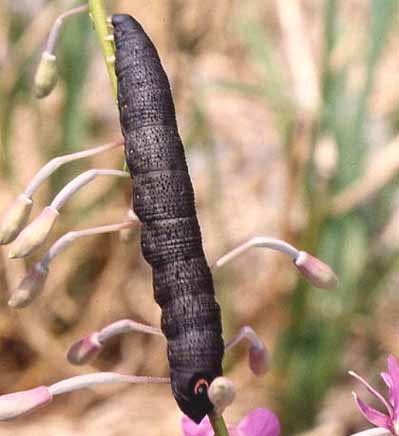Proserpinus flavofasciata

Proserpinus flavofasciata courtesy of Ward Strong,
BC Ministry of Forests.
This site has been created by
Bill Oehlke at oehlkew@islandtelecom.com
Comments, suggestions and/or additional information are welcomed by Bill.
TAXONOMY:
Family: Sphingidae, Latreille, 1802
Subfamily: Macroglossinae, Harris, 1839
Tribe: Macroglossini, Harris, 1839
Genus: Proserpinus Hubner, [1819] ...........
Species: flavofasciata Walker, 1856
|
MIDI MUSIC
.....It's a Wonderful World.....
copyright C. Odenkirk
ON.OFF
<bgsound src="world.mid" LOOP=FOREVER>
|
DISTRIBUTION:
The Yellow-banded day sphinx, Proserpinus flavofasciata
(Wing span: 39 - 49 mm), flies in Alaska south through British Columbia to Washington,
Oregon, Idaho, Wyoming, and Colorado, and from British Columbia east across southern Canada to Nova Scotia and
Maine.
I have not seen them on Prince Edward Island.

Proserpinus flavofasciata, Invermere, British Columbia,
May 2006,
courtesy of Matthew Holden.

Proserpinus flavofasciata, Invermere, British Columbia,
May 2006,
courtesy of Matthew Holden.
The upperside of the forewing is medium to dark brown with a faint to distinct white median band. The upperside
of the hindwing is dark brown with a wide orange median band which may not reach the inner margin. The moth mimics a bumblebee.
Many thanks to Edna Woodward and to Jeremy Gatten. Edna alerted me to Jeremy's beautiful image of a Proserpinus flavofascata nectaring, and he granted me
permission to post below and to the flavofasciata file.

Proserpinus flavofasciata, Fort McMurray, Alberta,
June 1, 2014, courtesy of Jeremy Gatten.
FLIGHT TIMES: Proserpinus flavofasciata adults fly as a single brood from April-June in
meadows in coniferous forests. Adults fly during the afternoon, nectaring from flowers including lilac, dandelion
and cherry.
Proserpinus flavofasciata, Invermere, British Columbia,
May 2006,
courtesy of Matthew Holden. |  |
ECLOSION:
Pupae probably wiggle to surface from subterranean chambers just prior to eclosion.

Proserpinus flavofasciata, Invermere, British Columbia,
May 2006,
courtesy of Matthew Holden.
SCENTING AND MATING:
Females call in the males with a pheromone released from a gland at the tip of the
abdomen.
EGGS, LARVAE, PUPAE: Larvae feed on willow weed (Epilobium) and possibly thimbleberry
(Rubus parviflorus).
Mature larvae pupate and overwinter in burrows dug under stones and other solid objects. The penultimate instar is
pale green with a pair of pale, dorsolateral lines running from the head to the base of the short caudal horn.
The last instar is brown-black with numerous black dots; caudal horn replaced by a black button surrounded by a white band
edged with black.
This larva, from southern Vancouver, is feeding on
Epilobium augustifolium.
Image courtesy of Jeremy B. Tatum
and Dr. John Snyder.
|  |






